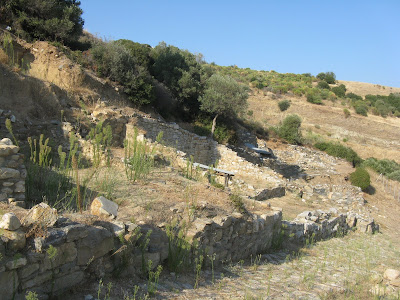The site is still not open for public viewing, no guides or information, other than that available on the internet is provided and the access is not easy, which made our excursion to the ruins quite exciting. Armed with a printing of pictures and descriptions of what is to be seen there, we stopped the car by the side of the road and roamed the hill of Palaiokastro. The place is so picturesque - a green hill with slopes, reaching the sea, that no wonder the ancients chose it for their city. I would gladly live there too.
The excavations have revealed the basis of several buildings, cobbled streets and a major agricultural building on the top of the hill, which was quite impressive. What struck me most about these ancient folks, however, was their sewage system. Medieval Europeans were in the habit of emptying their night pots on the streets, while the old Greeks had pipes to every house, all of which connected to a bigger pipe along the main street and down to the sea. Here's some more I found on the Internet:
The literary tradition dates the foundation of Argilos to 655/654 B.C. which makes Argilos the earliest Greek colony on the Thracian coast. Argilos occupied a privileged area and thus benefited from the trading activities along the Strymona and probably also from the gold mines of the Pangeion. The city enjoyed economic prosperity, at least until the foundation of Amphipolis in 437 B.C. Herodotus says that in 480, after crossing the Strymona, the Persian king Xerxès stopped at Argilos and forced its inhabitants into his army. After the Persian defeat, Argilos became member of the first Athenian confederation, paying 1,5 talents, a sum that proves that it was a rich city. But the foundation of Amphipolis, which took control of the trade along the Strymona, brought an end to this. Thucydides tells us that some Argilians took part in this foundation but that the relations between the two cities quickly deteriorated and, during the Peloponnesian war, the Argilians joined with the Spartan general Brasidas to attack Amphipolis. An inscription from the temple of Asklepios in Epidauros attests that Argilos was an independent city during the 4th century. Like other colonies in the area, the city was conquered by the Macedonian king Philip II in 357 B.C. Historians thought that the city was then abandoned, but excavations have brought to light an important agricultural settlement on the acropolis, which dates to the years 350-200 B.C. No roman or byzantine ruins have been uncovered.













No comments:
Post a Comment